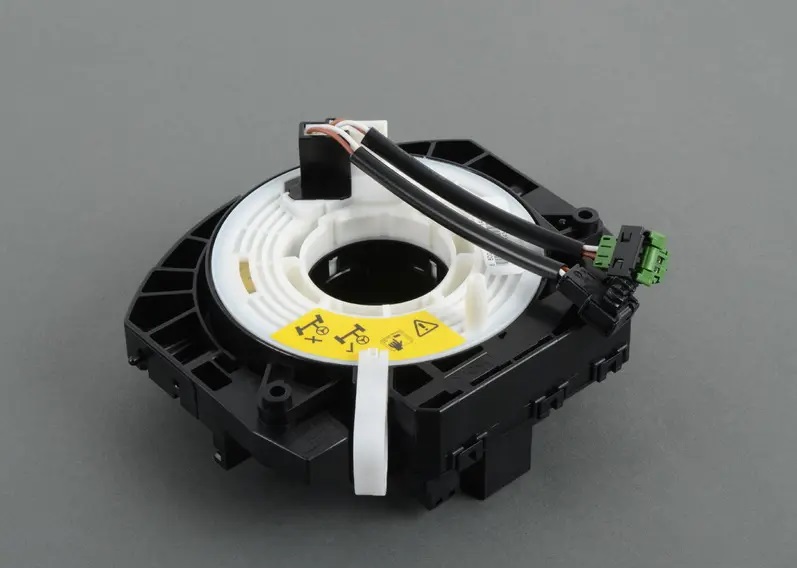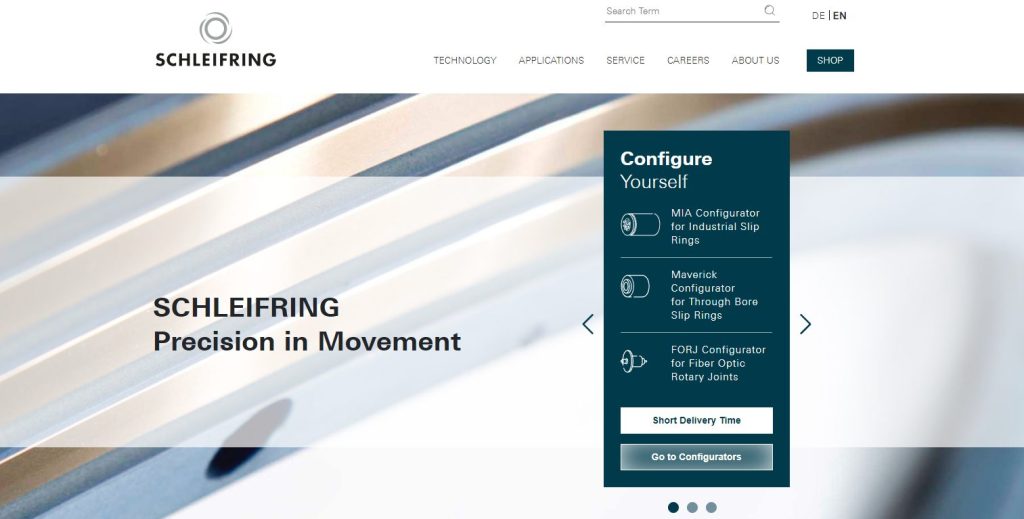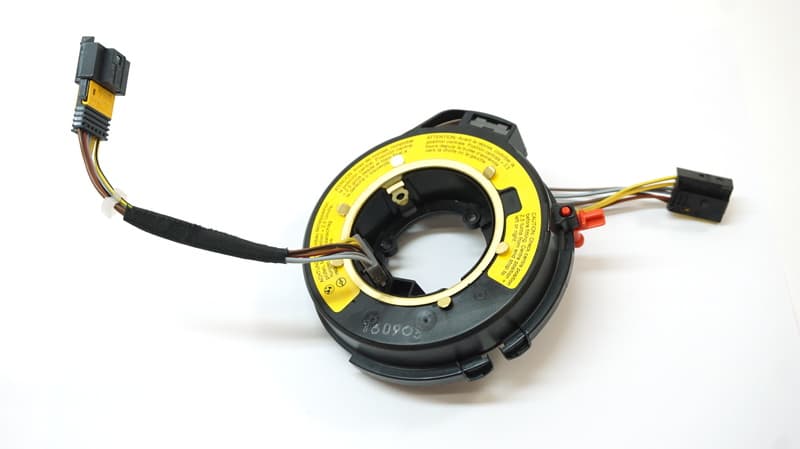The inception of automobiles can be traced back to the early 19th century, and since then, numerous developments have led us to the sophisticated vehicles we see today. One of the core components subjected to considerable evolution is indeed the steering wheel. The concept of steering wheels, which originated as simple levers in the earliest cars, has been refined over the years, adapting to meet technological leaps and advancements in safety and functionality.
In the midst of this evolution, the introduction of the slip ring steering wheel marked a significant milestone. These steering wheels are sophisticated electromechanical devices designed to permit the transmission of electricity from a stationary structure to a rotating one. In layman’s terms, they allow electrical connections to be made and maintained during the rotation of the steering wheel—an essential requirement for various electronic systems such as horn, audio controls, and more importantly, airbags.
In our modern era where vehicles are bedecked with technology, the significance of the slip ring steering wheel is increasingly apparent. Today, every turn of the wheel, every honk of the horn, and every shuffle of music involves the seamless operation of slip rings. They are a key element in maintaining the operational continuity of various control systems embedded within the steering wheel, making driving a smooth and enjoyable experience while enhancing safety protocols as well.
Thus, as we delve deeper into the aspects of slip ring steering wheels, it becomes evident how these devices, often overlooked, play such a vital role in our day-to-day vehicular operation. They are truly an embodiment of how far we’ve come in automotive innovation since the first humble steering levers two centuries ago.
Understanding Slip Ring Steering Wheels
Understanding the working mechanism and importance of slip ring steering wheels requires diving deep into their intricate design and functionality. The term “slip ring” in itself gives away a large part of its functional description – it’s a “ring” that “slips” or rather, allows slippage, thereby facilitating rotation while maintaining electrical connection.
In essence, a slip ring steering wheel is an assembly that enables the transmission of power and electrical signals from a stationary component to a rotating one. This electromechanical device becomes a conduit through which electricity can flow in a continuous, uninterrupted manner, regardless of the steering wheel’s position.
Now, let’s break down how they work. The basic operational model of a slip ring steering wheel rests upon two pivotal components: the ring and the brush. The brush, a part of the stationary component, maintains constant contact with the rotating ring, which is attached to the steering wheel. As the steering wheel rotates, the connection between the brush and ring is preserved, thereby allowing electrical signals or power to flow continuously across the interface. This ingenious mechanism is constantly at work, whether you’re simply changing the volume of your music, or activating more critical components like the vehicle’s airbag system.
In a more detailed component rundown, the major parts of a slip ring steering wheel include:
- Ring: This is a metal track that rotates with the steering wheel.
- Brush: This maintains a permanent connection with the ring, transmitting the electrical signal or power.
- Insulation materials: These components prevent electrical leakage between the adjacent rings and brushes.
- Housing: This acts as a protective cover, encasing the entire unit and protecting the internal components.
Understanding the working principle and knowing the functions of the various components helps appreciate just how critical slip ring steering wheels are in managing the various functionalities within a car seamlessly and effortlessly.

Why Slip Ring Steering Wheels are Necessary
Steering wheels have come a long way from being just rotational control devices to now serving as a command center for a plethora of vehicular functions. Slip ring steering wheels have become vital due to the ever-increasing integration of electronic and electrical subsystems in vehicles.
First, let’s discuss the role of slip ring steering wheels in modern vehicles. They facilitate seamless integration and operational efficiency of electrical components on the steering wheel. This connectivity is required for a wide range of controls and systems, including:
- Audio and media controls
- Cruise control
- Paddle shifters for semi-automatic cars
- Horn activation
- Steering wheel heating systems
- Monitoring systems such as tire pressure indicators and vehicle diagnostics
- Safety systems like airbags
The primary problem that slip rings solve is the need to maintain a reliable connection between stationary and rotating components of the steering wheel. Failure to ensure this connection could lead to loss of control over these essential systems, critically impacting vehicle safety and user experience.
Consider these real-world scenarios that underscore slip ring steering wheels’ importance:
- On long drives, using cruise control: Long drives can be exhausting for drivers. Utilizing cruise control on the steering wheel reduces fatigue and ensures uniform speed. Slip ring steering wheels ensure a secure and uninterrupted connection for cruise control functionality at all times, making it safer and more accessible.
- Emergency activation of horn: On busy roads, active horn usage is critical to prevent accidents or alert other vehicles. Slip ring steering wheels preserve horn functionality under all steering wheel positions, ensuring the driver’s safety and effective communication.
- Swift activation of airbags in accidents: An automobile accident might require instantaneous airbag deployment. Slip ring steering wheels guarantee that airbags deploy without delay, significantly enhancing vehicle occupants’ safety. Absence of a functional slip ring could mean a life-threatening delay or total failure of airbag deployment.
These real-world situations showcase the indispensability of slip ring steering wheels in ensuring our vehicles remain safe, responsive, and user-friendly, fulfilling the evolving expectations of modern automobile users.
Advantages and Disadvantages of Slip Ring Steering Wheels
Just like any mechanical component, slip ring steering wheels carry their unique set of advantages and disadvantages. Understanding these will provide an insight into why they’re still the go-to choice for many vehicle manufacturers, despite some inherent challenges.
Advantages
- Smooth Rotation: One of the foremost advantages of slip ring steering wheels is the unrivaled smoothness in rotation they offer. This is largely due to their design, involving a rotating ring and a stationary brush, coming together to facilitate an unrestricted, smooth rotation of the steering wheel under all conditions.
- Efficient Power Transfer: Slip ring steering wheels are excellent in transferring power and electrical signals from the stationary part of the vehicle to the rotating part (i.e., the steering wheel). This efficient transmission is essential for the uninterrupted operation of various controls on the steering wheel, from audio systems to cruise controls.
- Improved Functionality of Steering Wheel Controls: By ensuring a continuous flow of electrical signals, slip ring steering wheels enhance the overall functionality of steering wheel controls. This means all associated systems—be that your car’s horn, airbags, or entertainment systems—can operate flawlessly, greatly enhancing the driving experience.
Disadvantages
- Price: High-quality slip ring steering wheels don’t come cheap. Their intricate design along with the need for materials that can endure a constant rotation while maintaining a solid electrical connection means they can be quite costly. While this may be a small fraction of a vehicle’s overall price, it can add up in the case of replacements or maintenance.
- Required Maintenance: The constant contact between the brush and the ring results in wear that needs to be monitored. Over time, this wear and tear can lead to a reduced capacity to maintain an efficient electrical connection. This necessitates regular maintenance to ensure the slip ring steering wheel remains in perfect working condition.
Through understanding these pros and cons, it becomes easier to appreciate the complexities involved in designing a modern vehicle while recognizing the value of technological advancements like slip ring steering wheels, despite the accompanying challenges.
Slip Ring Steering Wheel Innovations
As with many aspects of automotive engineering, slip ring steering wheel technology is constantly advancing, with newer and more innovative designs continuously emerging. These advancements aim to create more efficient, reliable, and durable slip ring steering wheels to enhance overall vehicle performance and user experience.
Recent Advancements
- Compact and Modular Design: One recent innovation involves the development of slip ring steering wheels with compact, modular designs, allowing them to be easily integrated into various car models. This reduces production complexities and costs, making them a more viable choice for automotive manufacturers.
- Materials and Manufacturing Processes: Advancements have also been witnessed in the materials used and the manufacturing processes applied. The emphasis is on creating slip rings with improved electrical conductivity, lower friction coefficients, and increased wear resistance. Newer materials also mean less noise during operation, further enhancing the user experience.
- Improved Maintenance and Durability: Innovations focusing on enhancing durability and ease of maintenance have led to slip rings that require less frequent replacements, thereby reducing long-term maintenance costs. One such advancement is the use of precious metals for rings and brushes, extending the lifespan of these components.
Potential Future Trends
As for the future of slip ring steering wheels, the industry is likely to see some exciting changes geared towards improving the efficiency and functionality of these components.
- Increasing Integration with Vehicle Electronics: As cars become more advanced, they carry more electronic components on the steering wheel. The future might see the increased integration of these components with slip ring technology for seamless performance.
- Smart Technologies and Predictive Maintenance: With the advent of AI, smart technologies could be introduced to predict ring and brush wear, preemptively alerting for maintenance and avoiding system failures.
- Material Innovation: Besides metals, the future might see the use of composite materials or special alloys that are both durable and excellent conductors for slip ring steering wheels, further enhancing their lifespan and performance.
By focusing on these innovations and future trends, automotive engineers can ensure that slip ring steering wheels continue to flourish, adapting to new demands and technological advances, ultimately contributing to safer, more efficient, and more comfortable vehicles.
How to Choose the Right Slip Ring Steering Wheel
When it comes to purchasing a slip ring steering wheel, it’s vital to consider a range of factors to ensure compatibility, lifespan, and performance. There are many brands on the market, each offering different performance promises and unique selling propositions. However, below are the key aspects every car owner should evaluate when choosing a slip ring for their steering wheel:
Considerations when Buying a Slip Ring Steering Wheel
- Vehicle Type: Understanding your vehicle’s unique assembly and design specifications is crucial. Certain slip rings might perform optimally with specific car types or models, while some are designed to be universally compatible.
- Manufacturer’s Reputation: A manufacturer’s reputation can be very telling. Companies that have been in the business for many years and have a history of producing quality parts are usually a safer bet when buying vital vehicle parts such as slip rings.
- Customer Reviews: Customer reviews offer practical insights into the performance of the product. Positive reviews indicate satisfied customers and a product that delivers as promised. Carefully read through these reviews for any recurring issues or highlights.
- Price: Though not always the case, the price of a slip ring steering wheel can be a rough indicator of its quality. While it’s important to find a slip ring that fits within your financial plans, it’s equally critical not to compromise on quality for the sake of price, especially since the safety and operational efficiency of your vehicle is at stake.
Popular and Reliable Brands
Here are some renowned manufacturers known for their quality and reliable slip ring steering wheels:
| No. | Manufacturer | Website |
|---|---|---|
| 1 | Hangzhou Grand Technology | https://www.grandslipring.com/ |
| 2 | Moog Inc. | https://www.moog.com/ |
| 3 | Stemmann-Technik | https://www.stemmann.com/en/home |
| 4 | Schleifring | https://www.schleifring.com/ |
Hangzhou Grand Technology

Hangzhou Grand Technology Co., Ltd. started as a special slip ring manufacturer in 2011. Grown into slip rings, rotary joints, and slip ring assembly experts of today with 6,000 square meter manufacture complex.
Obtained ISO9001, Rosh, CE, and GJB9001B certificates a number of slip rings, rotary joint patents, and proud of our products can meet military grade. Collaborated with universities, institutes, and renowned factories across Asia and Europe including Panasonic, SIEMENS, CSIC, SAMSUNG, HUAWEI, etc.
Moog Inc.

Moog is a leading supplier of high-performance slip rings for various industries, including aerospace. Among their offerings, Moog’s SR Series Slip Rings are designed for the demanding environments of helicopters, excelling in performance, reliability, and customization potential.
Stemmann-Technik

Stemmann-Technik, a part of the Conductix-Wampfler Group, offers a broad range of slip rings, including solutions for helicopters. Their Livietta Slip Ring Assemblies are designed explicitly for harsh and demanding environments in the aviation sector, providing reliable signal and power transmission.
Schleifring

Schleifring is a well-known manufacturer of electromechanical systems, including slip rings customized for various industries. Their Aircraft Slip Rings cater specifically to helicopters, offering robust performance, low wear, and high reliability to meet the challenges of aviation applications.
If you want to know more about other slip ring manufacturers, you can read Top 10 Slip Ring Manufacturers in China, Top 10 Slip Ring Manufacturers In the USA Market 2023, and Top 10 Slip Ring Industry Key Manufacturers 2023
By weighing the discussed considerations and exploring reputed brands, car owners can ensure that they choose a slip ring steering wheel that best suits their needs, ensuring seamless operation of their vehicle’s features and an optimal driving experience.
Conclusion
The significance of slip ring steering wheels for modern vehicles cannot be overstated. With a deep understanding of their role and functionality, consumers can make informed decisions when purchasing new vehicles or replacing a slip ring steering wheel. Always remember to consider your requirements, research thoroughly, and choose wisely.


